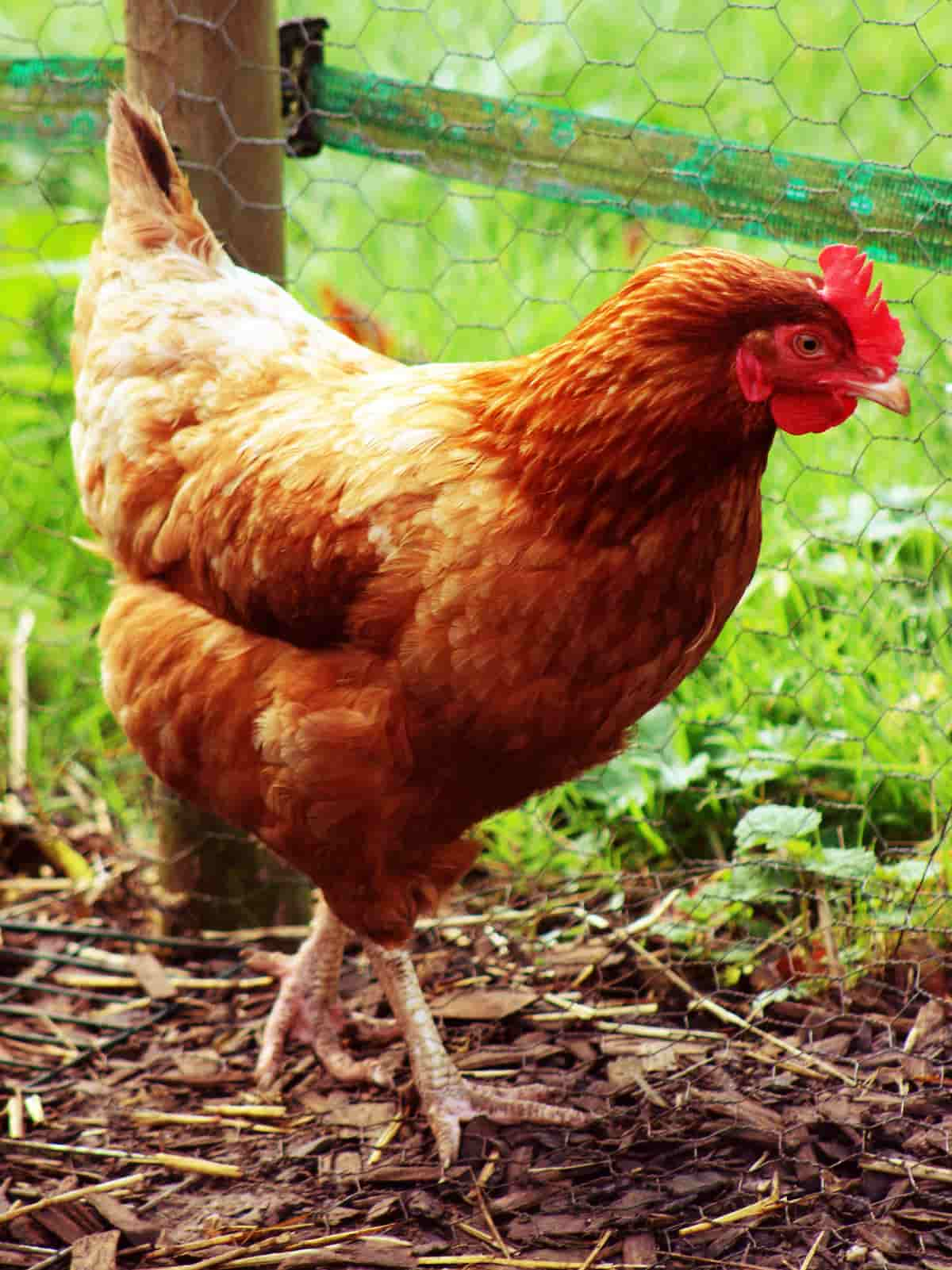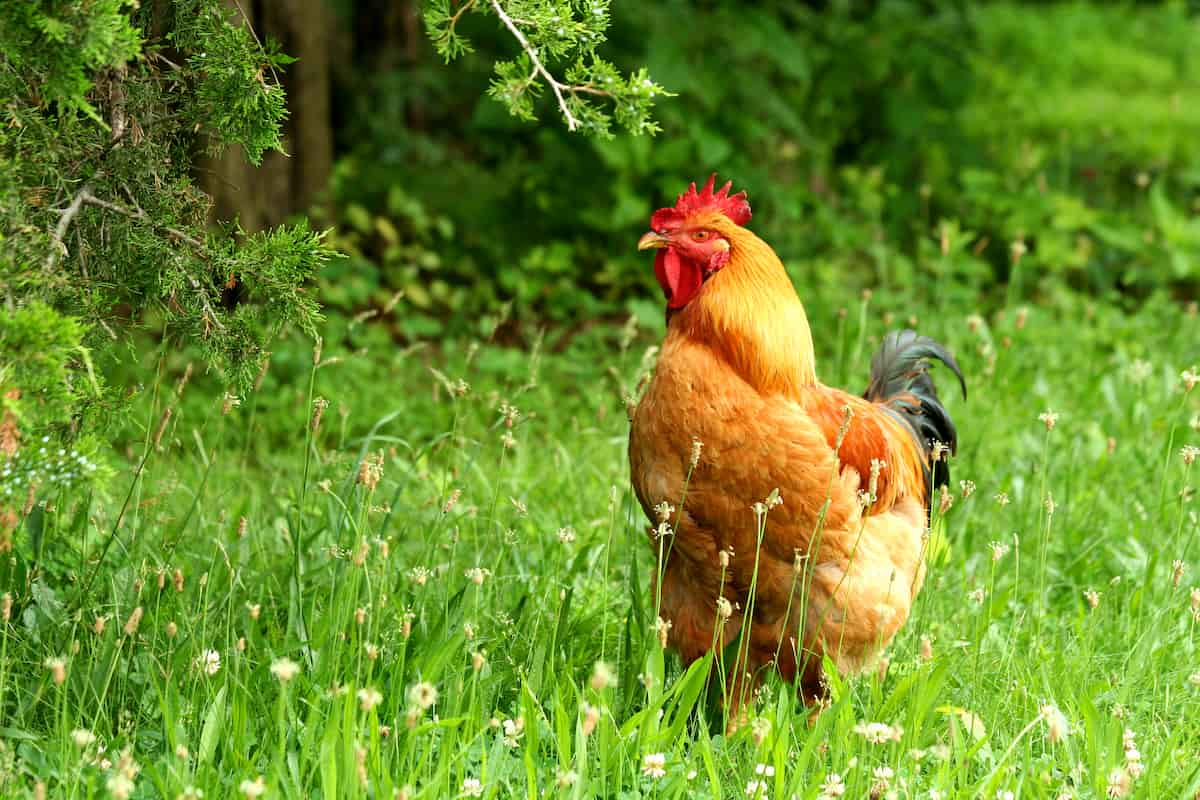The Rhode Island Red chicken is an American heritage breed developed in the late 19th century. The Rhode Island Red chicken quickly became a popular breed for egg and meat production. These chickens are relatively easy to care for and make great backyard chickens.

Guide to Rhode Island Red Chicken Breed
Average Lifespan of a Rhode Island Red Chicken
The lifespan of a Rhode Island Red chicken is 8 to 12 years. The key to healthy life for your chicken is providing them with a nutritious diet, clean water, plenty of space to roam, and regular check-ups from a vet.
Shelter for Rhode Island Red Chicken
The Rhode Island Red chickens are known for their hardiness and egg production. These are a good choice for backyard chicken keepers because they are relatively easy to care for. Regarding shelter, Rhode Island Reds do best in a coop with plenty of ventilation. The coop should be large enough for the chickens to move freely and roost comfortably. It’s important to keep the coop clean and free of predators.
These chickens do best in cold weather and tolerate colder temperatures than most chicken breeds. However, they still need access to shelter from the elements, so ensure your coop is well-insulated and has plenty of ventilation. You’ll also want to provide your birds plenty of space to move around and stretch their wings; a minimum of 4 square feet per bird is recommended.
Fencing for Rhode Island Red Chickens
Fencing is an important consideration for Rhode Island Red chickens, active birds that need space to roam. A good fence will protect your chickens from predators and allow them to explore their surroundings. When choosing a fence for your Rhode Island Reds, ensure it is tall enough to deter predators and strong enough to withstand the elements.
Feeding Tips for Rhode Island Red Chickens
- A good diet for Rhode Island Reds includes plenty of protein to support their rapid growth and calcium to help promote strong bones and shells. Here are some additional feeding tips to keep in mind:
- Offer a variety of different types of food, including both commercial chicken feed and scratch grains. This will give your chickens the nutrients they need while providing some variety in their diet.
- Provide fresh water at all times. Chickens always need access to fresh water to stay hydrated.
- Supplement your chickens’ diet with greens and other vegetables. Not only do greens provide valuable nutrients, but they also help improve your chickens’ gut health. Avoid giving your chickens processed foods or table scraps, as these can upset their digestive system.
Tips for Raising Rhode Island Red Chickens
- Choose the right location for your coop – Rhode Island Reds do best in areas with moderate climates.
- Feed your chickens a quality diet – A diet rich in protein and calcium will help your chickens stay healthy and produce plenty of eggs. Be sure to offer fresh water at all times as well.
- Keep your coop clean – Regular cleaning will help prevent disease and keep your chickens healthy. Once a week, remove all the bedding from the coop and scrub it well with soap and water. This means cleaning their living quarters regularly and ensuring plenty of fresh water. A dirty environment can lead to respiratory problems and other illnesses.
- Watch for parasites – Chickens can be susceptible to mites and lice. These can cause skin irritation and feather loss. Inspect your chickens regularly and treat them if necessary.
- Vaccinate them – Vaccinating your chickens will help protect them from diseases such as Newcastle disease and Marek’s disease. Consult with a veterinarian about which vaccines are appropriate for your chickens.
- Handle them gently – Chickens can be easily stressed, making them more susceptible to illness. Handle them gently and avoid rough handling or loud noises around them.
In case you missed it: Ultimate Guide to Polish Chicken Breed: Characteristics, Care, Feed, and Health Care

Rhode Island Red Weight
Regarding weight, Rhode Island Red roosters typically weigh around 3.85 kg, while hens usually weigh about 2.95 kg.
Characteristics of the Rhode Island Red Chicken
- Rhode Island Red chickens are the most popular chicken breeds in the USA. They are known for their egg-laying abilities and their docile nature. These chickens are usually very friendly and make great pets.
- Rhode Island Reds are considered a dual-purpose chicken breed, meaning they can be used for eggs and meat. They are also fairly disease-resistant, making them a good choice if you start raising chickens. Regarding feeding your Rhode Island Reds, these chickens are not particularly fussy eaters. They will do well on a standard poultry feed mix or layer pellets. You can also supplement your diet with some scratch grains or fresh greens.
- The Rhode Island Red chicken is an adaptable bird that can be raised in various climates. They are hardy birds that do well in cold weather and can withstand hot weather better than other breeds. Rhode Island Reds are good foragers and do well on free-range farms. They are also resistant to many common poultry diseases.
Health Care for Rhode Island Red Chickens
- One of the most popular chicken breeds is the Rhode Island Red. They are a dual-purpose breed, meaning they can be used for eggs and meat. They are also one of the hardiest chicken breeds, which is why they are so popular. However, although they are a hardy breed, they still need proper care and attention. This includes proper health care.
- Chickens should be vaccinated against diseases like Newcastle disease, Marek’s disease, and Avian Influenza. These diseases can be deadly to chickens, so it’s important to vaccinate your birds against them.
- Vaccinations should be given by a qualified veterinarian familiar with chicken health care. The vet will also need to know the age of your chickens and whether or not they have been vaccinated before.
- Chickens can get parasites such as mites and lice. These parasites can cause a lot of irritation and even lead to death in extreme cases. To prevent parasites, you should regularly check your chickens for them and treat them if necessary. There are several products available that will kill parasites on contact. You can also dust your chickens with an insecticidal powder to help keep parasites away.
- They can live happily in a small backyard coop and run. Rhode Island Reds are also very tolerant of cold weather, so they should not be kept indoors during winter unless temperatures drop below freezing. Rhode Island Reds are easy to care for and require minimal maintenance. They require fresh water and a good diet, including fresh vegetables and fruits.
Rhode Island Reds Egg Production
Rhode Island Reds can lay up to 200–300 brown eggs annually. Egg production will generally decline after the first few years, but with proper care, your Rhode Island Red can continue laying eggs well into its senior years.
In case you missed it: Ultimate Guide to Ayam Cemani Chicken Breed: Characteristics, Care, Feed, and Health Care

Conclusion
The Rhode Island Red is a popular chicken breed for backyard farmers and commercial producers. The resulting chicken was a hardy bird well-suited for cold weather climates and produced large brown eggs.
- Feed Your Flock for Less: Top 10 Tips to Save on Chicken Feed
- Ultimate Guide to Ossabaw Island Hog: Breeding, Raising, Diet, and Care
- Hatching Answers: The Top 10 Reasons Your Chickens Aren’t Laying Eggs
- Eggs and Economics: Breaking Down the Cost of Raising Backyard Chickens
- Defend Your Greens: Proven Methods to Keep Iguanas Out of Your Garden
- Ultimate Guide to Cinnamon Queen Chicken: A Comprehensive Guide for Beginners
- Ultimate Guide to California Tan Chicken: Breeding, Raising, Diet, Egg-Production and Care
- Ultimate Guide to Marsh Daisy Chicken: Breeding, Raising, Diet, and Care
- 10 Types of Chicken Farming Businesses You Can Start for Profits